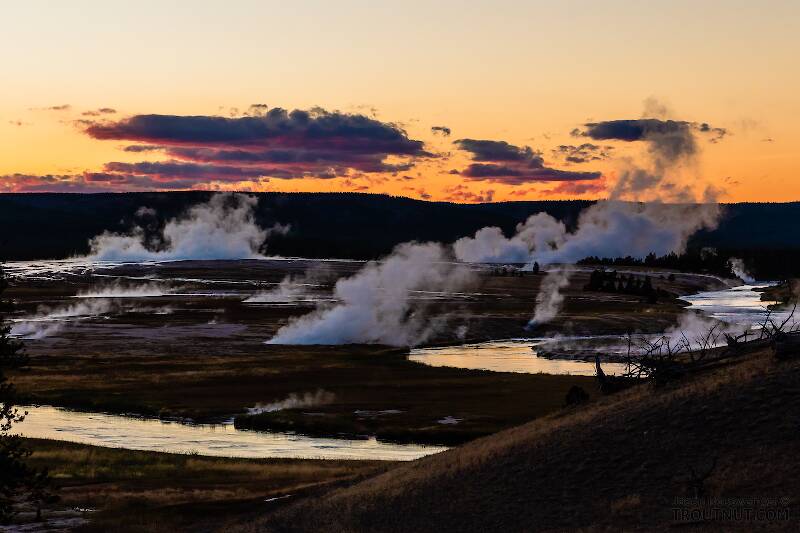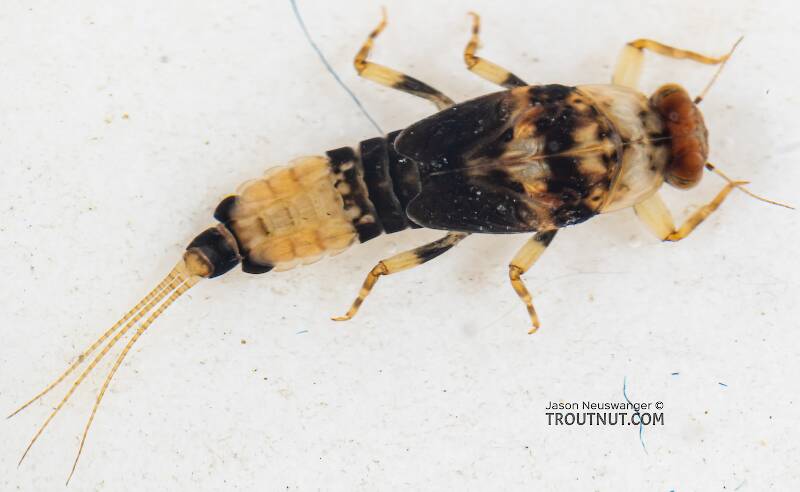
Blue-winged Olives
Baetis
Tiny Baetis mayflies are perhaps the most commonly encountered and imitated by anglers on all American trout streams due to their great abundance, widespread distribution, and trout-friendly emergence habits.
Featured on the forum
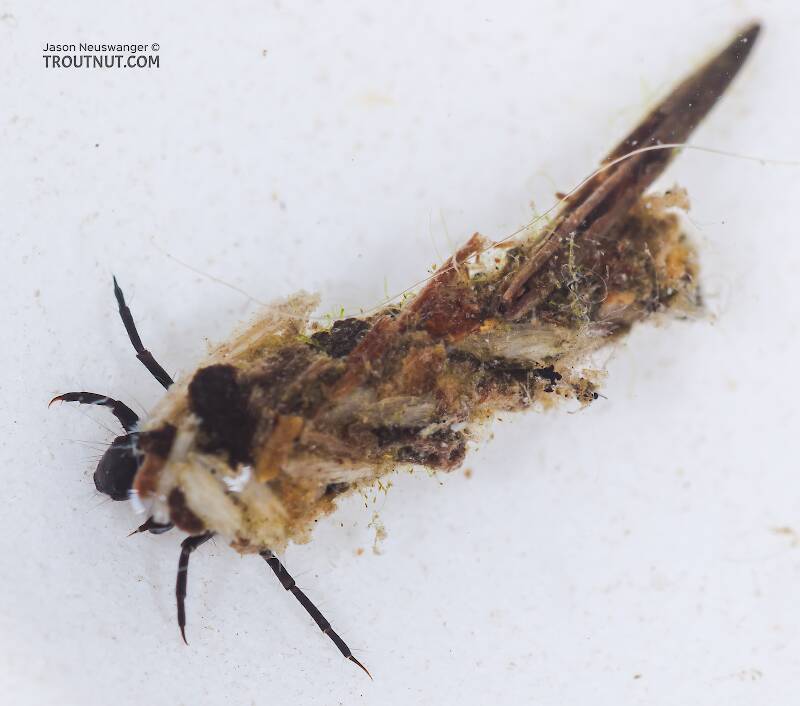
This seems to be a young larva of Limnephilus. Although not clear in the picture, several ventral abdominal segments have chloride epithelia.

Troutnut is a project started in 2003 by salmonid ecologist Jason "Troutnut" Neuswanger to help anglers and
fly tyers unabashedly embrace the entomological side of the sport. Learn more about Troutnut or
support the project for an enhanced experience here.
Small Blue-Winged Olives
Like most common names,"Small Blue-Winged Olive" can refer to more than one taxon. They're previewed below, along with 4 specimens. For more detail click through to the scientific names.
Mayfly Species Drunella lata
These are pretty much always called Small Blue-Winged Olives.
When Selective Trout was first published in 1971, Swisher and Richards included Drunella lata (Small Blue-Winged Olive, Slate-Winged Olive) as a Midwestern "superhatch." Although it can also be found in many Eastern trout streams, it is probably more important to Midwestern anglers. Typically a morning emerger, this species often competes for the attention of trout with more abundant Tricorythodes and small baetids during parts of July and August. For this reason, the authors of Selective Trout considered the concentrated evening spinner falls to be more important than the somewhat sporadic morning emergence. From an angling standpoint, this situation is nearly the opposite of the earlier Drunella cornuta emergence in the East, where the morning emergence is usually the main event and spinner falls are often of little consequence.
Currently, Drunella lata shares its name with another mayfly, the former D. longicornis. That mayfly can be important in mountainous areas in the Southeast, but they are larger and the nymphs lack the distinctive pale markings mentioned in the Juvenile Characteristics section. (The information on this page does not describe D. longicornis)
Currently, Drunella lata shares its name with another mayfly, the former D. longicornis. That mayfly can be important in mountainous areas in the Southeast, but they are larger and the nymphs lack the distinctive pale markings mentioned in the Juvenile Characteristics section. (The information on this page does not describe D. longicornis)
Mayfly Species Drunella cornutella
These are often called Small Blue-Winged Olives.
Few anglers can claim to have fished to hatches of this little olive mayfly, even though the species has been mentioned in popular angling entomologies like Caucci and Nastasi's Hatches or Knopp and Cormier's Mayflies. On many of the larger Eastern freestones, their emergence happens after the waters have warmed and dedicated anglers have turned their attention to streams that remain cold: headwaters, spring creeks, or tailwaters. Because good populations are usually not found in tiny streams, it is on some the Eastern tailwaters, like the branches of the Delaware, that fly fishers take notice of this species.
Drunella cornutella looks like a Mini-Me version of Drunella cornuta. In streams where the two species cohabit, size is the only easy way to tell them apart. Although there is some slight overlap between the largest cornutella and the smallest cornuta, the average difference is usually pretty obvious. Both share very similar coloration and morphology in all stages, even down to the little curved horns coming out of the frontal shelves of the nymph's heads.
Drunella cornutella looks like a Mini-Me version of Drunella cornuta. In streams where the two species cohabit, size is the only easy way to tell them apart. Although there is some slight overlap between the largest cornutella and the smallest cornuta, the average difference is usually pretty obvious. Both share very similar coloration and morphology in all stages, even down to the little curved horns coming out of the frontal shelves of the nymph's heads.
Mayfly Species Attenella delantala
These are often called Small Blue-Winged Olives.
I've never come across this species in the angling literature, but I found several mature nymphs in a kicknet sample in a small stream around 3,000 feet in the Washington Cascades in late July. Their coloration is striking.
See 1 more specimen...
Mayfly Species Attenella soquele
These are often called Small Blue-Winged Olives.
Mayfly Species Dannella simplex
These are sometimes called Small Blue-Winged Olives.
Although by no means a superhatch, this species can be important. Authors who discuss it lament the general lack of credit it receives for the fine hatches it produces on some streams.
Mayfly Species Attenella attenuata
These are very rarely called Small Blue-Winged Olives.
This intriguing species has received a lot of attention in past angling books. Recent authors suspect that much of this credit was a case of mistaken identity, with Attenella attenuata receiving praise for the hatches of Drunella lata and Dannella simplex. Much of the credit was legitimate and accurate, but this species is no longer thought to be on par with its most popular cousins in Ephemerella and Drunella.
I have several specimens listed under this species, but I'm not positive the identification is correct.
I have several specimens listed under this species, but I'm not positive the identification is correct.
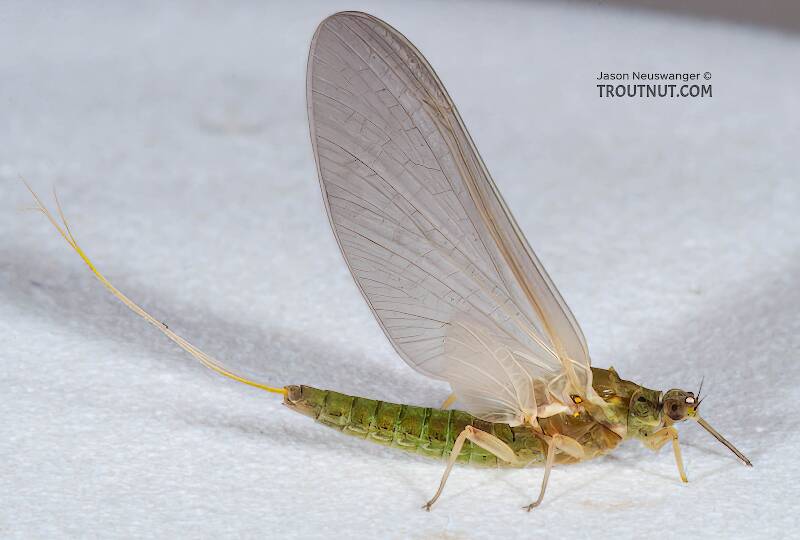
This specimen came from the same hatch as a male.
See 2 more specimens...
Mayfly Species Attenella margarita
These are very rarely called Small Blue-Winged Olives.
Though having a national distribution, this species is considered by angling authorities to be important only in the West. In localized waters where it is abundant, it can be a significant hatch.
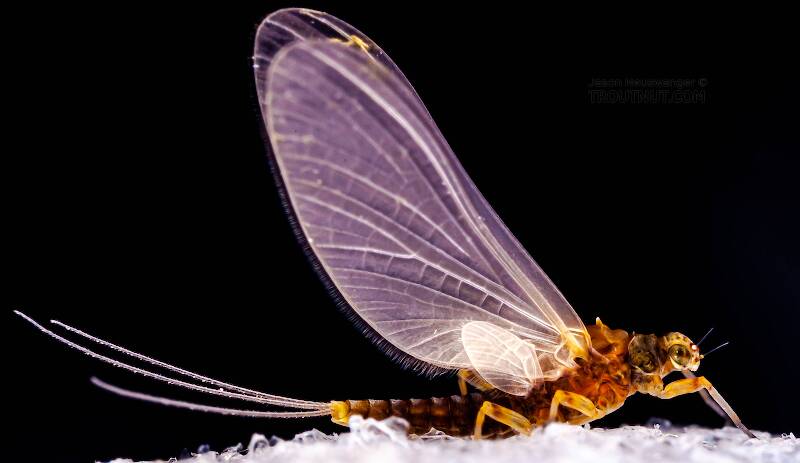
I found this dun unusually late in the year for anything in the Ephemerellidae family in the East. It's also small for that family.
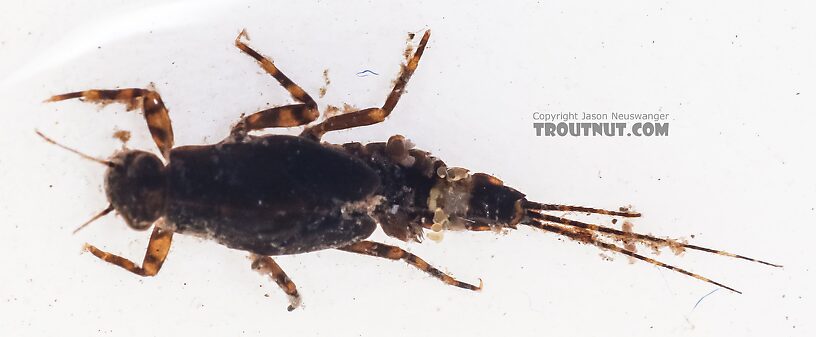
Notes from the microscope on the ID: Maxillary palp is present, distinctly 2-segmented, but very small. Gills on segment 4-7. This specimen has some unfortunate damage to the abdomen, but it's the only one I found in my sample.
References
- Swisher, Doug and Carl Richards. 2000. Selective Trout. The Lyons Press.

